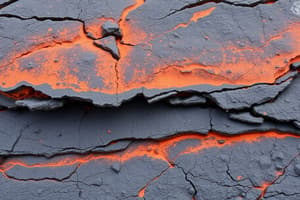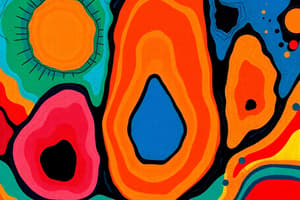Podcast
Questions and Answers
What process occurs when magma melts surrounding rock and alters its composition during its ascent?
What process occurs when magma melts surrounding rock and alters its composition during its ascent?
- Differentiation
- Mixing of Magmas
- Partial Melting
- Assimilation (correct)
Which of the following processes is responsible for the crystallization of minerals from magma in the mantle?
Which of the following processes is responsible for the crystallization of minerals from magma in the mantle?
- Mixing of Magmas
- Differentiation (correct)
- Assimilation
- Partial Melting
What mechanism enables different magmas with varying compositions to combine in the mantle?
What mechanism enables different magmas with varying compositions to combine in the mantle?
- Assimilation
- Mixing of Magmas (correct)
- Differentiation
- Partial Melting
During which process is magma generated near the Earth's surface due to melting at lower temperatures than surrounding rock?
During which process is magma generated near the Earth's surface due to melting at lower temperatures than surrounding rock?
What is a key difference between the processes of magma generation on Earth and the Moon?
What is a key difference between the processes of magma generation on Earth and the Moon?
What defines igneous rocks?
What defines igneous rocks?
Which term refers to the processes of rock formation?
Which term refers to the processes of rock formation?
What is the primary factor influencing the composition of magma?
What is the primary factor influencing the composition of magma?
Which process cannot occur in a vacuum?
Which process cannot occur in a vacuum?
Which component is most commonly associated with magma?
Which component is most commonly associated with magma?
What is considered the 'compound liquid' in geological terms?
What is considered the 'compound liquid' in geological terms?
Which temperature is significant for the radiation process in rocks?
Which temperature is significant for the radiation process in rocks?
What is the term for the description and classification of rocks?
What is the term for the description and classification of rocks?
What is the primary source of heat affecting the melting of rocks in the solid earth?
What is the primary source of heat affecting the melting of rocks in the solid earth?
Which process is NOT a factor that generates magma?
Which process is NOT a factor that generates magma?
Which radioactive element has a half-life greater than $10^9$ years contributing to heat production in Earth?
Which radioactive element has a half-life greater than $10^9$ years contributing to heat production in Earth?
What occurs at the mid-ocean ridge during the crustal geothermal process?
What occurs at the mid-ocean ridge during the crustal geothermal process?
What causes the increase in temperature required for rock melting?
What causes the increase in temperature required for rock melting?
How does the movement of a down going slab generate heat for melting?
How does the movement of a down going slab generate heat for melting?
What is a likely consequence of a decrease in pressure beneath the Earth's surface?
What is a likely consequence of a decrease in pressure beneath the Earth's surface?
What process contributes to the initial heating of Earth's interior during core formation?
What process contributes to the initial heating of Earth's interior during core formation?
Flashcards
Igneous Petrology
Igneous Petrology
The study of igneous rocks and the processes involved in their formation.
Petrography
Petrography
The description and classification of rocks.
Petro-genesis
Petro-genesis
The conditions under which rocks were formed.
Magma
Magma
Signup and view all the flashcards
Lava
Lava
Signup and view all the flashcards
Igneous Rock
Igneous Rock
Signup and view all the flashcards
Magma composition
Magma composition
Signup and view all the flashcards
Magma generation
Magma generation
Signup and view all the flashcards
Sources of Heat for Melting Rocks
Sources of Heat for Melting Rocks
Signup and view all the flashcards
Subduction Zone Melting
Subduction Zone Melting
Signup and view all the flashcards
Heat Increase for Magma Generation
Heat Increase for Magma Generation
Signup and view all the flashcards
Pressure Decrease and Magma
Pressure Decrease and Magma
Signup and view all the flashcards
Crustal Geothermal Gradients
Crustal Geothermal Gradients
Signup and view all the flashcards
Global Heat Flow
Global Heat Flow
Signup and view all the flashcards
Bowen's Reaction Series
Bowen's Reaction Series
Signup and view all the flashcards
Core Formation
Core Formation
Signup and view all the flashcards
Magmatic Differentiation
Magmatic Differentiation
Signup and view all the flashcards
Crystal Settling
Crystal Settling
Signup and view all the flashcards
Partial Melting
Partial Melting
Signup and view all the flashcards
Assimilation
Assimilation
Signup and view all the flashcards
Magma Mixing
Magma Mixing
Signup and view all the flashcards
Study Notes
Course Information
- Course number: Geol. 402
- Course title: Igneous and Metamorphic Petrology
- Instructor: Dr. Adnan Khan, Assistant Professor, Department of Geology
- Recommended textbook: Petrology: Igneous, Sedimentary, and Metamorphic by Harvey Blatt and Robert J. Tracy
Petrology Overview
- Petrology is the study of rocks, encompassing igneous, sedimentary, and metamorphic rocks.
- This includes their genetic distribution, classification, and formation processes.
Igneous Petrology
- The scientific study of igneous rocks
- Two key components:
- Petrogenesis: The processes of rock formation
- Petrography: The description of rocks, including their classification
Nature of Magma
- Magma is a naturally occurring, hot fluid within the Earth.
- It's a molten substance at high temperatures.
- It is called magma until it erupts on the surface, at which point it is called lava.
Magma Composition
- Magma is chemically complex, containing molecular building blocks for minerals.
- Mostly composed of silicates, along with oxides and sulfides of metals.
- Always contains water and other gases held in solution by pressure, with heat as the principle factor.
Magma Generation
- Magma forms when temperatures at depth in the Earth exceed the melting temperatures of rocks.
- This can occur through three primary processes, or a combination of them.
Sources of Heat for Melting Rocks
- Solar radiation: Minor heat source (50,000 times less potent than other sources)
- Core movement: Significantly contributes to melting by heat transfer
- Radioactive decay (U, U, Th, K, and Rb): A substantial heat source, contributing up to 50-100% of the Earth's internal heat.
Factors Generating Magma
- Increase of heat: Raises melting temperature, causing rocks to melt and form magma.
- Decrease of pressure: Causes phase change in rock, generating magma.
Processes Generating Magma
- Radiation: Emission of EM energy from hot bodies into surrounding bodies. Increasingly important at very high temperatures (>1200°C).
- Conduction: Transfer of kinetic energy via atomic vibrations. More efficient if the surface area of the enclosure is larger.
- Convection: Movement of material with contrasting temperatures, due to different densities. Crucial in magma generation.
Magma Evolution
- Differentiation: Separation of substances with different chemical compositions within a magma body.
- Partial Melting: Different minerals melt at different temperatures, resulting in magmas with different compositions depending on what minerals are present and the conditions.
- Assimilation: Incorporation of surrounding country rock into a magma body, altering its chemical composition.
- Mixing of Magmas: The mixing of two or more magmas with different compositions, which can create a new, intermediate composition.
Bowen's Reaction Series (diagram illustrated)
- This series describes the order in which minerals crystallize from a cooling magma.
Global Heat Flow Models (diagram illustrated)
- Global heat flow patterns are shown with warmer areas over spreading ridges and colder areas over cratons.
Studying That Suits You
Use AI to generate personalized quizzes and flashcards to suit your learning preferences.




